
scrounge: /skrounj/ informal verb: to actively seek [books] from any available source
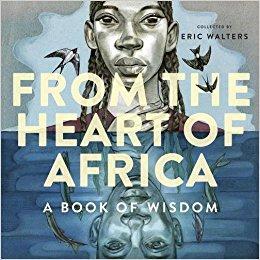
From the Heart of Africa: A Book of Wisdom is a short picture book that includes some sayings/proverbs/aphorisms from people groups on the African continent. As the foreword notes, since aphorisms are universal, the ones found in one region are often similar to those found in other parts of the world, but each is a unique attempt to distill life experience into a short proverb that can communicate wisdom.
Each of the fifteen sayings are illustrated by different artists -- most of whom are from African countries or Canada. The variety of styles and color schemes helps illustrate the diversity of oral cultures that these traditional sayings originate from. Each one also includes a general source (at least to the extent that this can be known), and a brief explanation of the saying.
I like how some of these sayings are familiar ("Many hands make light work"), while others seem more unique ("I pointed out to you the stars, but all you saw was the tip of my finger"). There is also a good mix of proverbs that celebrate community, along with others that encourage independence and creativity.
(Thanks to NetGalley for the review copy.)
Scrounged From: NetGalley
Format: Kindle
Author: Eric Walters
Illustrators: Many! Each illustrator is identified with a brief bio at the end of the book.
Pages: 38
Content Advisory: None

Artist Dahlov Ipcar died this past February, but today would have been her 100th birthday. In addition to a long career as an artist, she spent most of her life farming in the state of Maine (my home state).
Since I lack any familiarity with the "art world" in general, I probably would not have known much about her work if it had not been for her delightfully illustrated board books published by Islandport Press, which we first discovered when my oldest child was a baby.
After reading one, it became easier to spot her distinctive style when I saw it elsewhere, since her work is celebrated in many places in the state.
I love her use of color and joyful depictions of animals (both wild and domestic). Here are some of her books we've enjoyed the most:
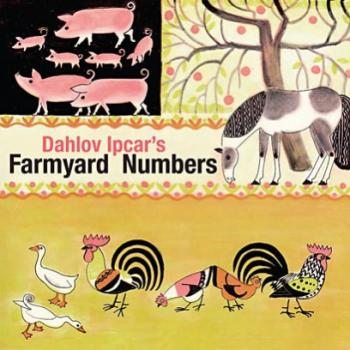
1. Farmyard Numbers was our introduction to Ipcar's art. It's a simple one-to-ten counting board book featuring favorite farm animals, and gentle rhyming text. Several of the illustrations in this book are cropped from larger scenes in Ipcar's earlier, longer book about the trials and joys of farm life called Hardscrabble Harvest.
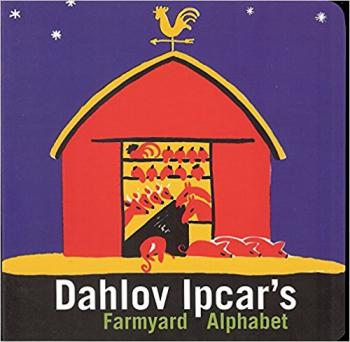
2. Farmyard Alphabet continues with the farming theme (which Ipcar had quite a lot of experience with). Short rhyming lines show us a different aspect of farm life for each letter -- Q for quilt, T for tractor ("that does everything"), E for eggs, J "is for jars, of jellies and jams," etc.
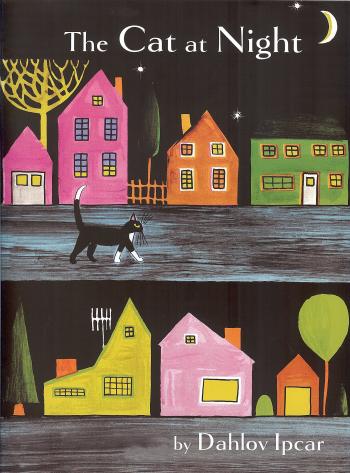
3. The Cat at Night is a wonderful look at the difference between what a cat can see at night and what a person can see. The pages alternate between dark silhouetted scenes and brighter versions of the same scene, showing how the cat knows where to go even when it's dark to us. My children enjoyed trying to find the cat on the silhouetted pages.
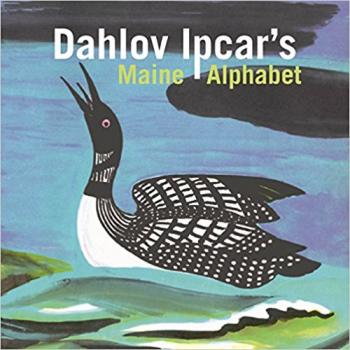
4. Dahlov Ipcar's Maine Alphabet board book is a beautiful celebration of the state that was her home for most of her life. From the coast to the woods (L for lobster and M for moose, of course), this is a lovely rhyming romp through the great state of Maine.
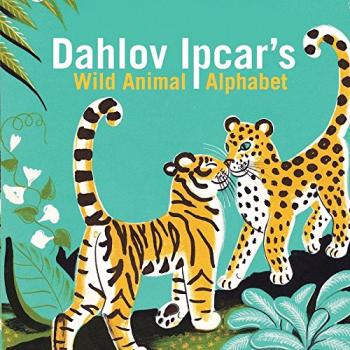
5. I love the different color combinations in Wild Animal Alphabet -- so many earth tones and golds paired with vibrant blues and greens. Once again, the illustrations are accompanied with rhyming text that's "short and sweet" enough to hold the attention of toddlers. From ibex to quail to "zebra, who always comes last," this is a lovely and fun look at wild animals (including a few doing nontypical things like the kangaroo beating on drums).
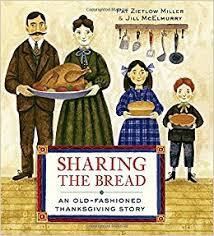
Sharing the Bread is a simple, rhyming celebration of an old-fashioned Thanksgiving dinner, more accessible for younger children than Sarah Gives Thanks, but set in approximately the same time period.
The book features warm and cheery illustrations, and introduces various members of an extended family as they go about their tasks of preparing for Thanksgiving dinner. Everyone has a job to do -- even the baby, which is mostly just to sleep while others work! At the end, the family joins hands and gives thanks for food and family.
I loved the nostalgia evoked here, and the simplicity of the process, but for young children it can also serve as a broad reminder (since a year is a long time for a little one) of what Thanksgiving is all about.
Scrounged From: Our local library
Format: Hardcover
Author: Pat Zietlow Miller
Illustrator: Jill McElmurry
Pages: 32
Content Advisory: None
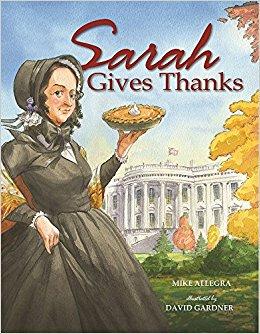
While the name "Sarah Josepha Hale" did ring a bell to me when I picked up Sarah Gives Thanks: How Thanksgiving Became a National Holiday, I couldn't have told you much of anything about her. After reading this book, I have a newfound appreciation for this intelligent, enterprising woman and her contributions to our country's development -- beyond just Thanksgiving.
Oftentimes our "first Thanksgiving" stories revolve around the narrative of that first harvest festival celebrated by the Jamestown settlers and Wampanoag tribe. But this biography of Hale focuses on her quest to have Thanksgiving declared a national holiday. While it was a tradition in the early 1800s, it was only celebrated in some regions, and even then on different days. Sarah Hale wrote to every president for decades until finally Abraham Lincoln agreed with her in the midst of the Civil War.
As important as this aspect of the story is, I was even more intrigued by Hale's determination to attain an education (in a round-about way) in the days when women did not go to college. I was also inspired by her marriage and subsequent industrious widowhood, as well as her obvious ability to bring people together through reading, writing, and publishing (which included encouraging women to be more concerned about their minds than their wardrobes).
Scrounged From: Our local library
Format: Hardcover
Author: Mike Allegra
Illustrator: David Gardner
Pages: 32
Content Advisory: None
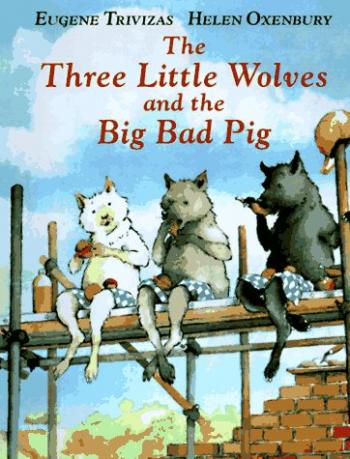
"Revised" fairy/nursery tales are all over the place these days. We grew up hearing these stories told over and over again, and now we've apparently decided we need to either modernize substantially, and/or pull a role reversal to freshen things up a bit.
The results can be hit or miss, but one such tale I've enjoyed lately is The Three Little Wolves and the Big Bad Pig, which was originally published in 1993 (even before Ella Enchanted!). Of course, the title is funnier if a child has read the original Three Little Pigs first.
This story begins as expected, with three wolf siblings going off into the world to seek their fortunes, and being warned to beware of the big bad pig. The building materials get a bit of an update though: brick is only the beginning. We also see concrete, armor plates, and even a video entrance phone. This big bad pig seems to have shallower lungs than the wolf of lore, for he has to resort to other efforts to fullly knock down houses, such as a sledgehammer and even dynamite.
Despite the raised stakes in the building battle, these illustrations are gentle and not at all over-the-top. Helen Oxenbury illustrated a series of board books for babies that I grew up with, so it's nice to see her work again.
I won't spoil the ending, but in keeping with the rest of this retelling, it's quite opposite from the original, which I think in this case is a satisfying thing.
Scrounged From: My husband's book stash
Format: Hardcover
Author: Eugene Trivizas
Illustrator: Helen Oxenbury
Pages: 32
Content Advisory: None

